The Philadelphia Museum of Art is an amazing cultural showcase. It’s one of the best museums in the United States and a must visit on any Philadelphia itinerary.
In this guide, I give you an overview of the museum and identify 20+ of its must see masterpieces. I also give you must know tips for visiting.
At the foot of its grand steps, you’ll find the iconic bronze statue of Rocky, a beloved fictional character in Philadelphia’s lore.
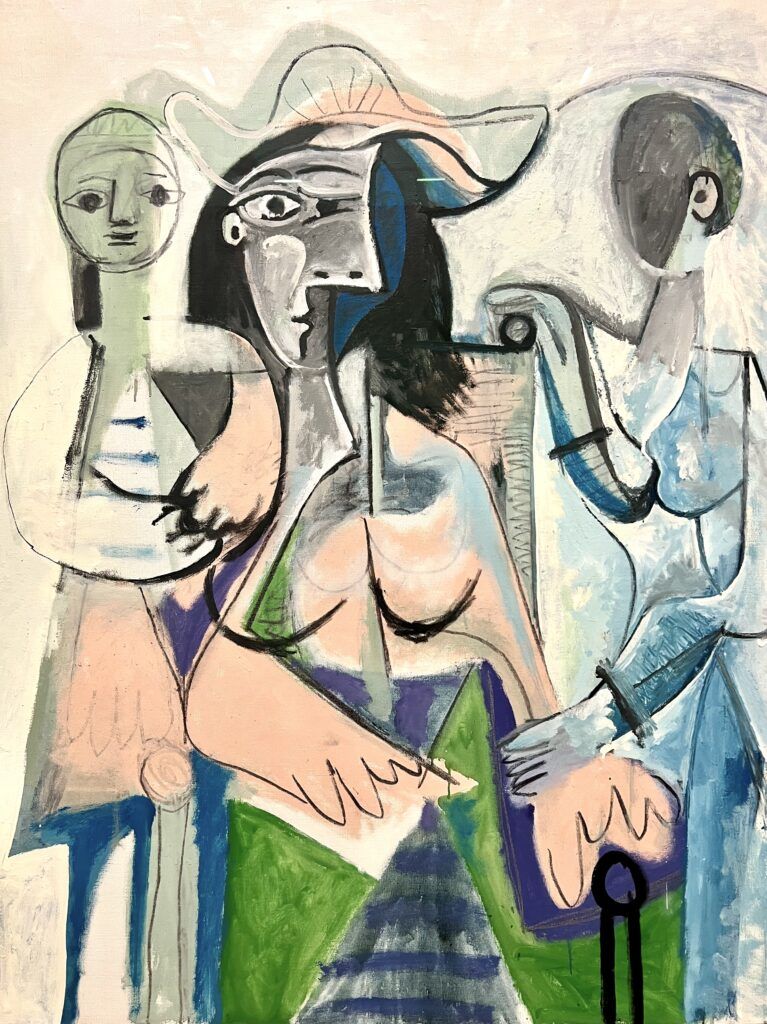
For a bit of fun, channel your inner Rocky and jog up the iconic steps. At the top awaits a grand Neo-Classical building that looks like a Greek temple.
Overview Of The Philadelphia Museum of Art
The museum is renowned for its American and European art. The American pieces are among the finest collection in the country, with works by Thomas Eakins, Charles Wilson Peale, Jonathan Singleton Copley, Mary Cassatt, and Benjamin West.
It also houses an impressive collection of Medieval art, British art, and Asian art. It’s especially strong in Impressionist works, with pieces by Monet, Manet, Renoir, Pissarro, and Degas. And it has Post-Impressionist pieces by the likes of Van Gogh and Cezanne.
Not only that, the museum boasts the world’s most important collections of Marcel Duchamp and Constantin Brancusi outside Europe.
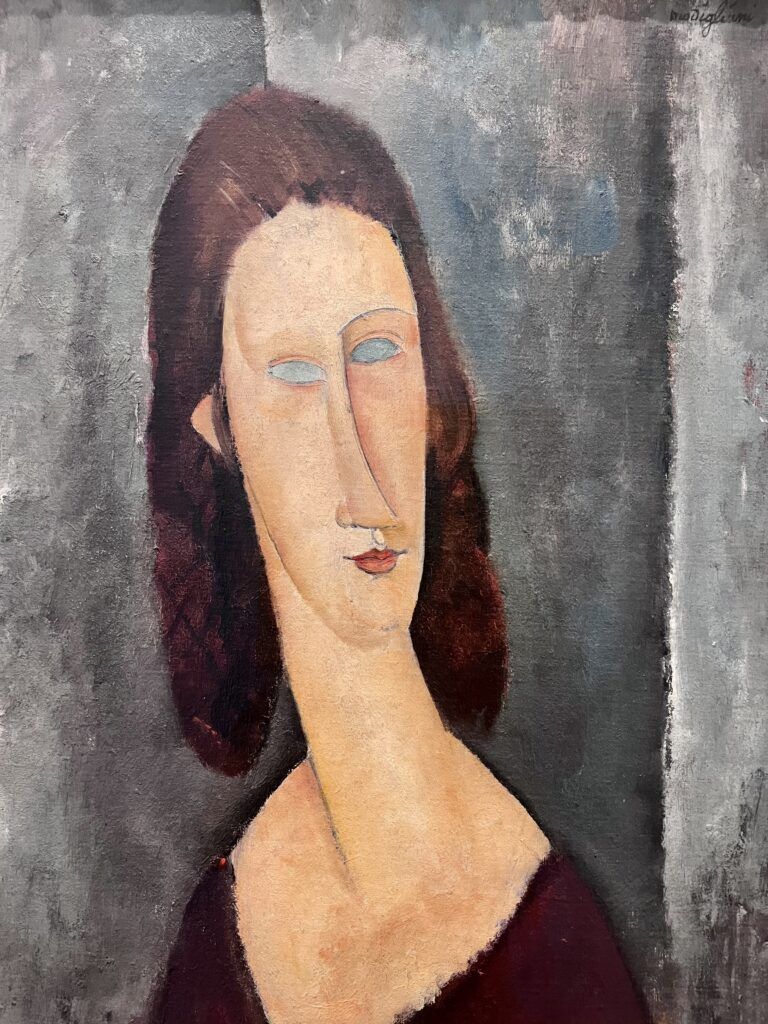
On the first floor, you’ll find the western entrance. This is where you’ll enter if you’ve been strolling along the Skuykill River. It houses important works of American art.
On the second floor, you’ll find more American art, European art from 1850-1900, and modern and contemporary art.
The Impressionism and Post-Impressionism works seem to draw the most crowds. The most famous pieces are in the Resnick Rotunda.
On the third floor you’ll find Asian art, Medieval art from 1100-1500, European art from 1500-1850, British art, and a few American period rooms. There’s also a collection of armor. But that was closed when I visited.
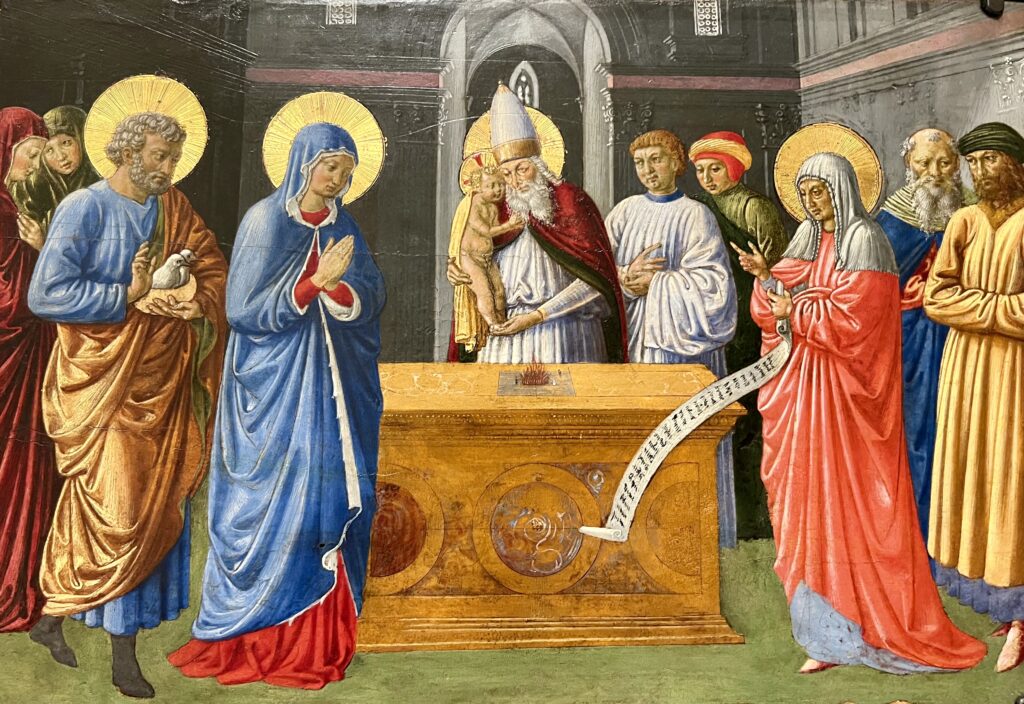
There’s also a temporary exhibition space. And be aware that some of the famous pieces may be traveling and thus not on display.
From 2017 to 2021, the museum underwent a renovation by renowned architect Frank Gehry, known as the “Core Project.” Gehry transformed the subterranean infrastructure on the ground and first floor.
But it has none of Gehry’s trademark flash and stainless steel. Rather, it’s a hushed intervention that does justice to the historic Beaux Arts building.
He added an impressive 20,000 square feet of additional gallery space, a revitalized central atrium, a switchback central staircase, and a vaulted walkway for hosting performances and gatherings.
When you enter and buy your ticket, you can pick up a map of the museum.
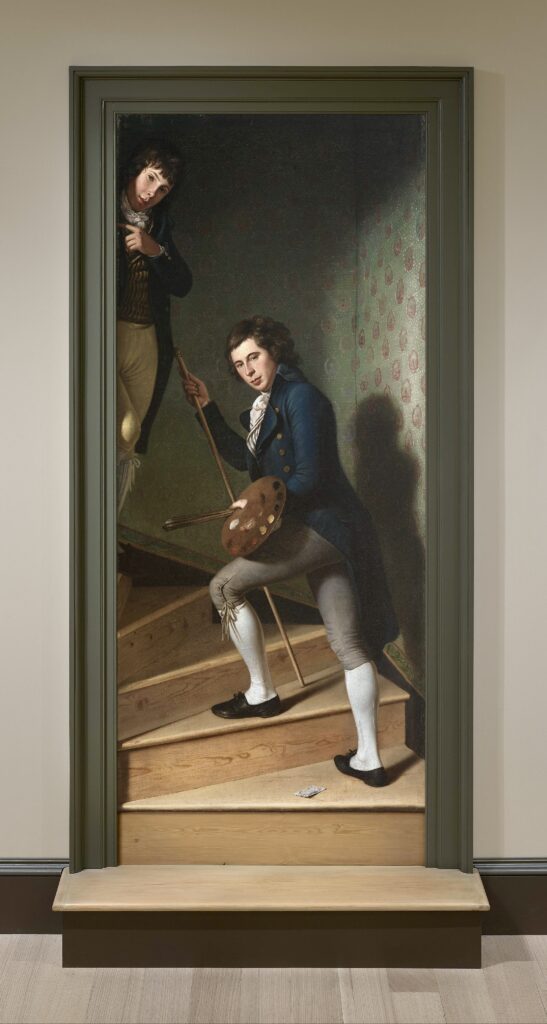
Guide To The Philadelphia Museum of Art: Must See Masterpieces
Here are 21 amazing artworks and things you can’t miss at the Philadelphia Museum of Art.
1. Peale, Staircase Group
The cornerstone of the museum’s American collection arrived In 1945, when the museum purchased Charles Willson Peale’s famous trompe l’oeil painting The Staircase Group. It’s considered a masterpiece of American portraiture.
It’s an illusionistic painting that features two of his sons, Raphaelle Peale and Titian Ramsay Peale, on a winding staircase.
The life size portrait is significant because it challenged traditional portrait conventions of the time. Instead of the standard formal poses, Peale depicted his sons in a relaxed and informal manner.
The painting captures a candid moment as the boys ascend the stairs. It’s notable for its composition and the sense of movement it conveys.
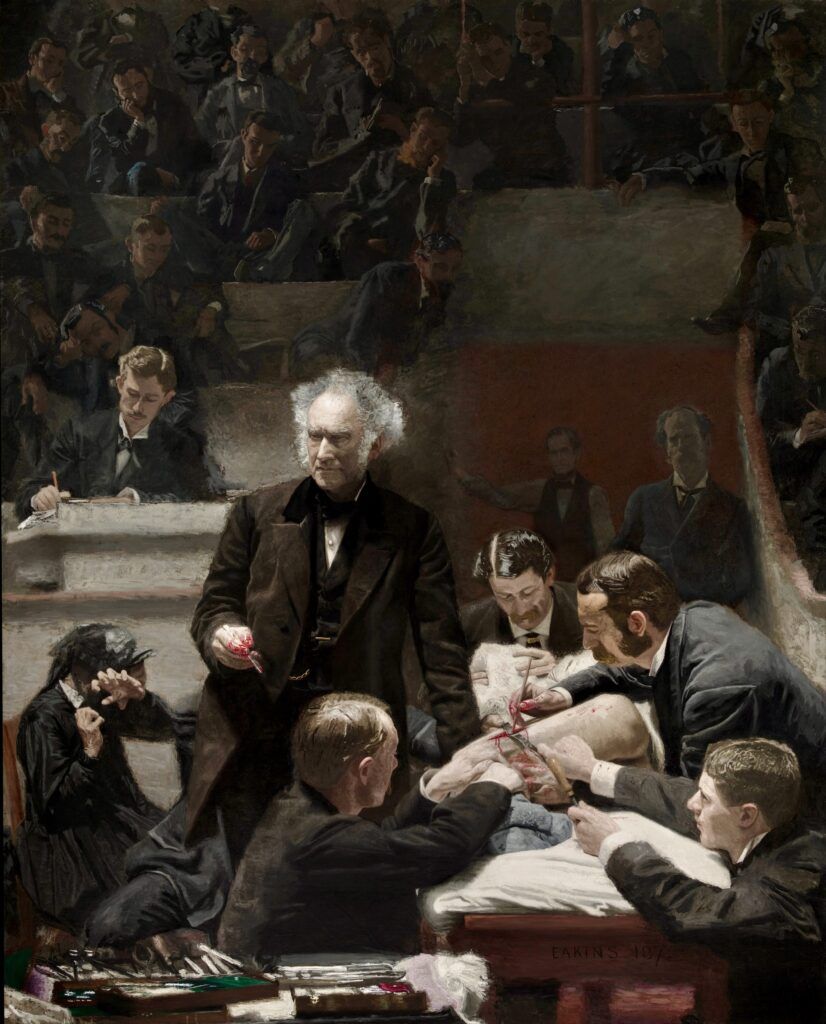
2. Thomas Eakins, The Gross Clinic
Thomas Eakins’ The Gross Clinic is among the greatest American paintings ever made. It depicts a dramatic surgical scene in a lecture room at Jefferson Medical College in Philadelphia.
Dr. Samuel D. Gross, a prominent surgeon, is shown performing surgery on a patient’s leg while surrounded by medical students and colleagues.
The painting is known for its realistic and detailed portrayal of the surgical procedure, with blood and instruments prominently featured. When it was unveiled, it was considered too gruesome for polite society.
But it’s a significant work because it captures the intensity and seriousness of medical education in the 19th century. It’s also a beautiful composition reflecting Eakins’ mastery of detail, light, and shadow.
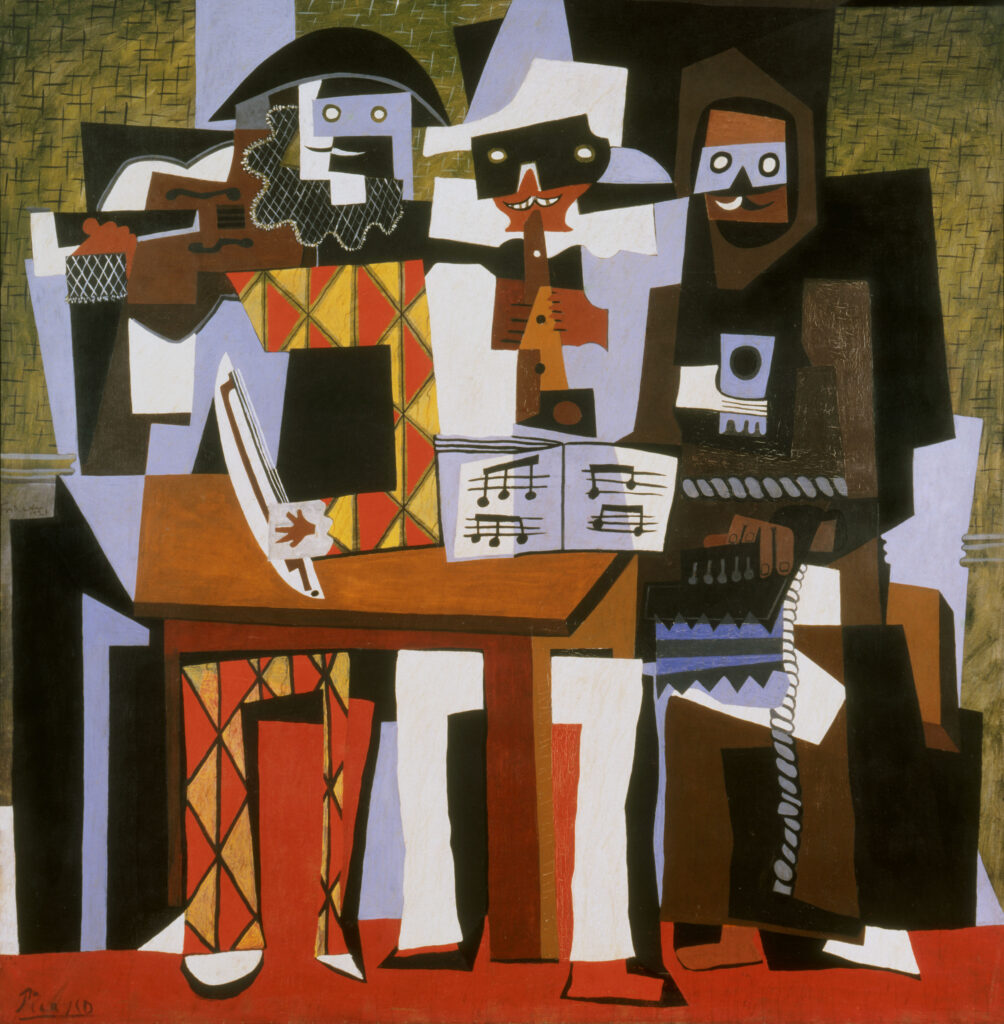
3. Pablo Picasso, The Three Musicians
Three Musicians is a large canvas painted by the most famous painter of the 20th century, Pablo Picasso.
It was the grand finale of his Cubism period and part of a series he completed in 1921. In Cubism, the subject consists of a series of planes, lines, and arcs. This approach forces the viewer to reconstruct and reassemble the subject.
Picasso’s composition is pieced together from thin and angular planes that don’t really match up. Three musicians sit in a shallow box-like room. They are dressed as the familiar Italian Commedia dell’arte theater figures that Picasso loved.
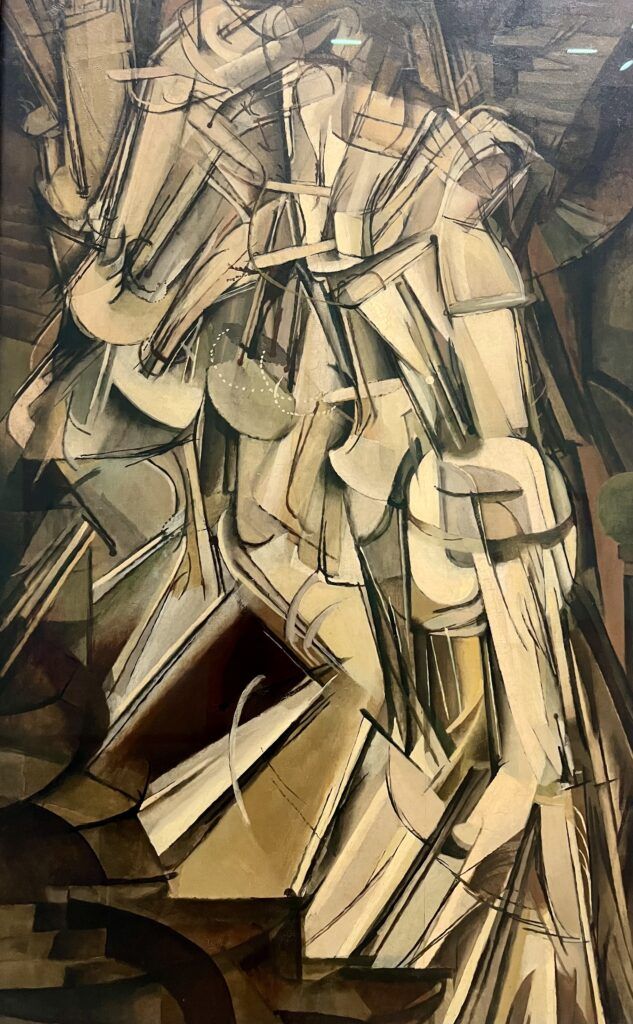
4. Marcel Duchamp, Nude Descending a Staircase
The museum has entire rooms dedicated to Marcel Duchamp. He was a renowned Conceptual artist.
Initially, he worked in artists’ groups including Cubism. But he threw off those shackles and became one of the most original thinkers in modern art history. His motto was “I am interested in ideas, not merely in visual products.”
The prompted him to created some of his “readymades,” like the museum’s Fountain. It’s simply a toilet presented as “art.”
While Fountain was one of the most notorious works in art history, I prefer the artist’s Nude Descending A Staircase. This painting also caused a sensation when it was exhibited.
In it, the traditional female nude is transformed into a mechanized moving form. Duchamp achieves this effect with a combination of Cubist techniques and the aesthetic of a flip book style of animation.
5. Vincent Van Gogh, Sunflowers
Van Gogh was a Dutch Post-Impressionism artist who spent most of his life in France. His work is known for its swirling line, raw emotional intensity, and bold vivid color.
This still life was part of the artist’s second series of sunflower paintings. It’s the only sunflower in a US museum.
Van Gogh created it when he lived in Arles, in southern France. He wanted to decorate the house for the arrival of his friend and fellow artist Paul Gauguin.
He said he wanted the sunflowers to look like “stained glass in a Gothic cathedral.” He painted them with thick stabbing brush strokes of ochre and red against a turquoise background. The flowers are energetic and seem to take on a life of their own.
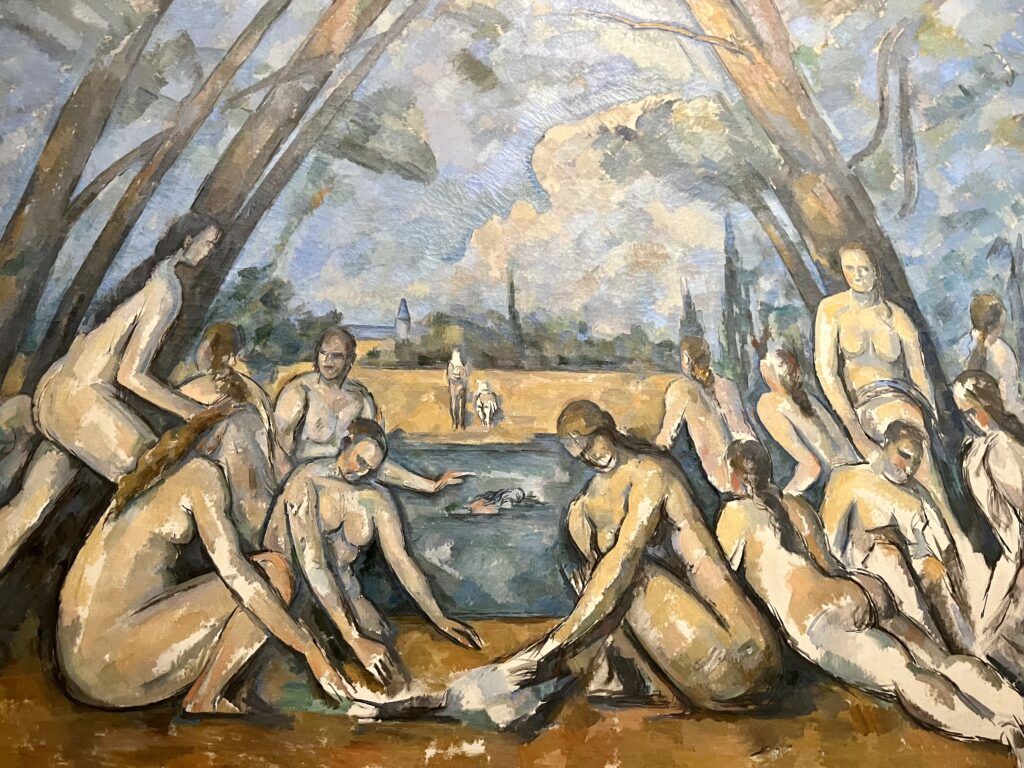
6. Cezanne, Large Bathers
Paul Cezanne was a pioneering Post-Impressionist artist.
His innovative use of color, form, and geometric shapes profoundly influenced the development of 20th century art, bridging the gap between Impressionism and Cubism.
Despite being modern, Cezanne had a profound interest in classicism. In particular, he was fascinated with the theme of bathing parties and nude women in landscapes. The topic dominated the last two decades of his life.
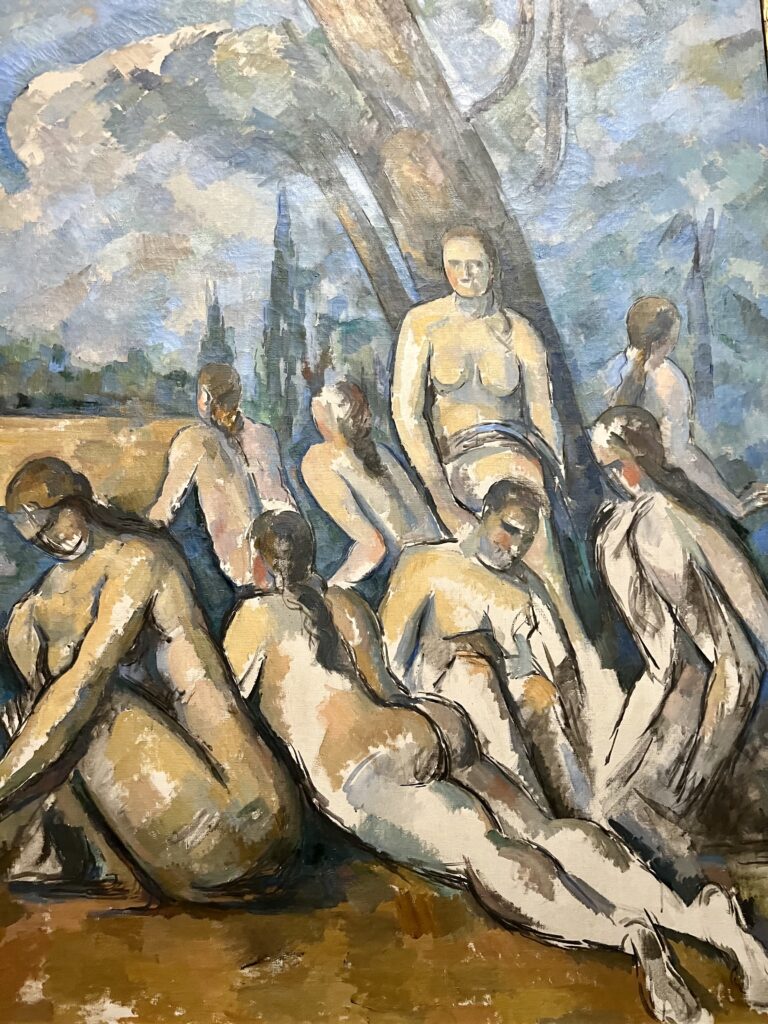
Cezanne’s Large Bathers occupies pride of place as the centerpiece of the Resnick Rotunda. The museum acquired the painting in 1937. It was the artist’s grandest rendition of this theme.
It’s a complex, unpolished scene. Cezanne used geometric shapes, bold brushwork, and fragmented and distorted forms. The bathers are still, de-eroticized, and strangely austere.
For myself, I am not that fond of the artist’s rather awkward bathers. They are not conventionally beautiful, almost missing actual hands and feet. But their radical originality redefined how to depict a nude and even the nature of painting itself.
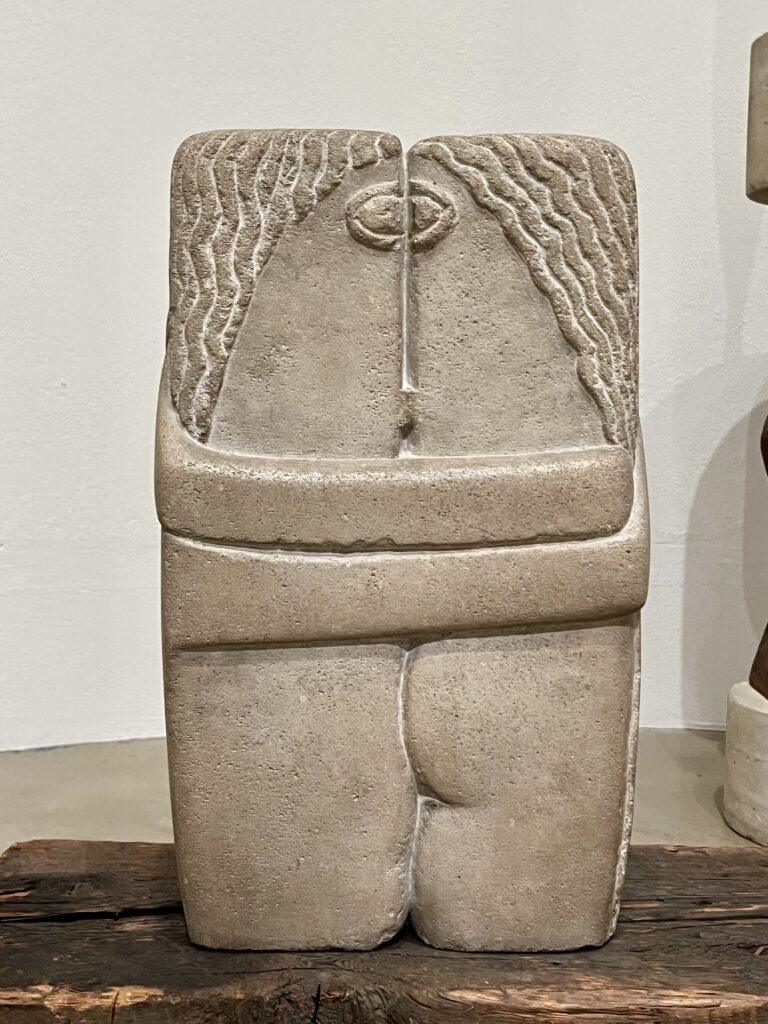
7. Constanin Brancusi, The Kiss
Born in Romania, Brancusi studied fine arts before moving to Paris. But he broke with traditional sculptural methods. He adopted a minimalist, abstract style, reducing a subject to its essential elements.
In The Kiss, he shows two embracing forms that merge into a single form. Two eyes become a single eye. Hairlines make a continuous arch.
The sculpture embodies Brancusi’s belief that art should capture the spiritual and emotional essence of its subject, rather than merely replicating its physical appearance.
There are also several versions of Brancusi’s famous Bird in Space and Princess X.
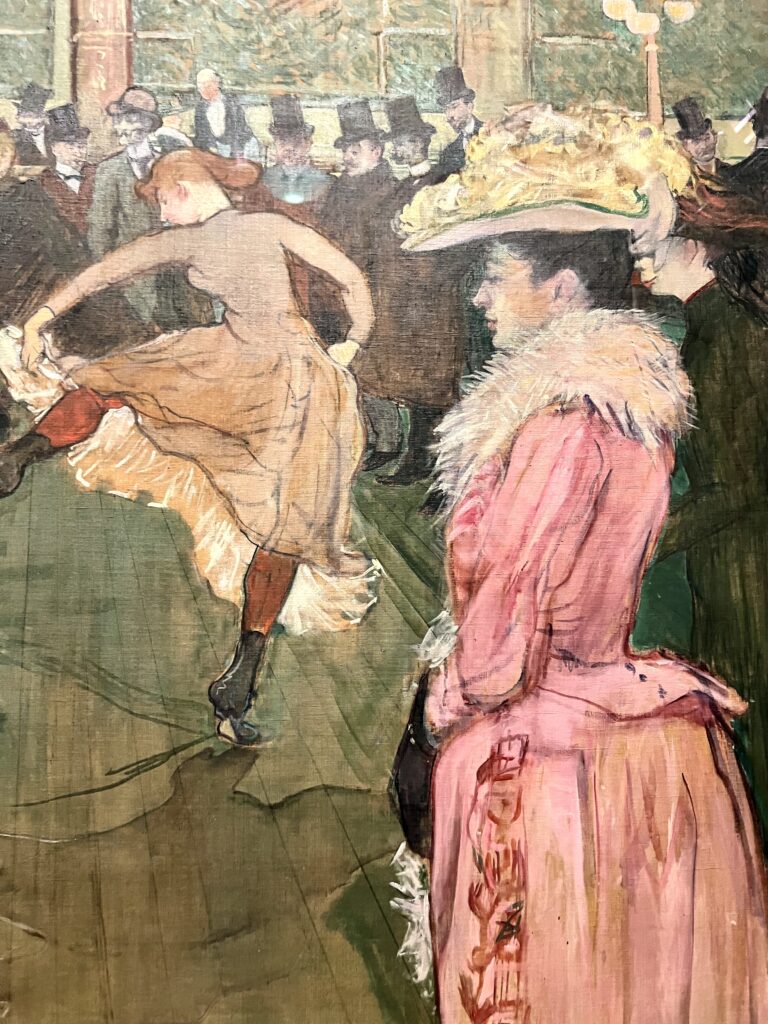
8. Toulouse-Lautrec, At The Moulin Rouge
Toulousee-Lautrec was one of the greatest Post-Impressionist painters in France. He’s most well known for iconic posters of bawdy fin de siècle spots in Montmartre, like the Moulin Rouge.
There’s no judgment or moralizing in his paintings. Toulouse-Lautrec simply tried to capture his subjects daily life and languid boredom.
His art was marked by his innovative use of color, particularly flat areas of color, and strong, fluid lines. This would go on to influence the Fauves and the Expressionists.
Lautrec was a regular at the Moulin Rouge. This scene captures a training lesson of the new dancers by Valentine “the Boneless.” It has a sense of spontaneity, inviting the viewer into the spectacle.
READ: Guide to the Toulosue-Lautrec Museum in Albi France
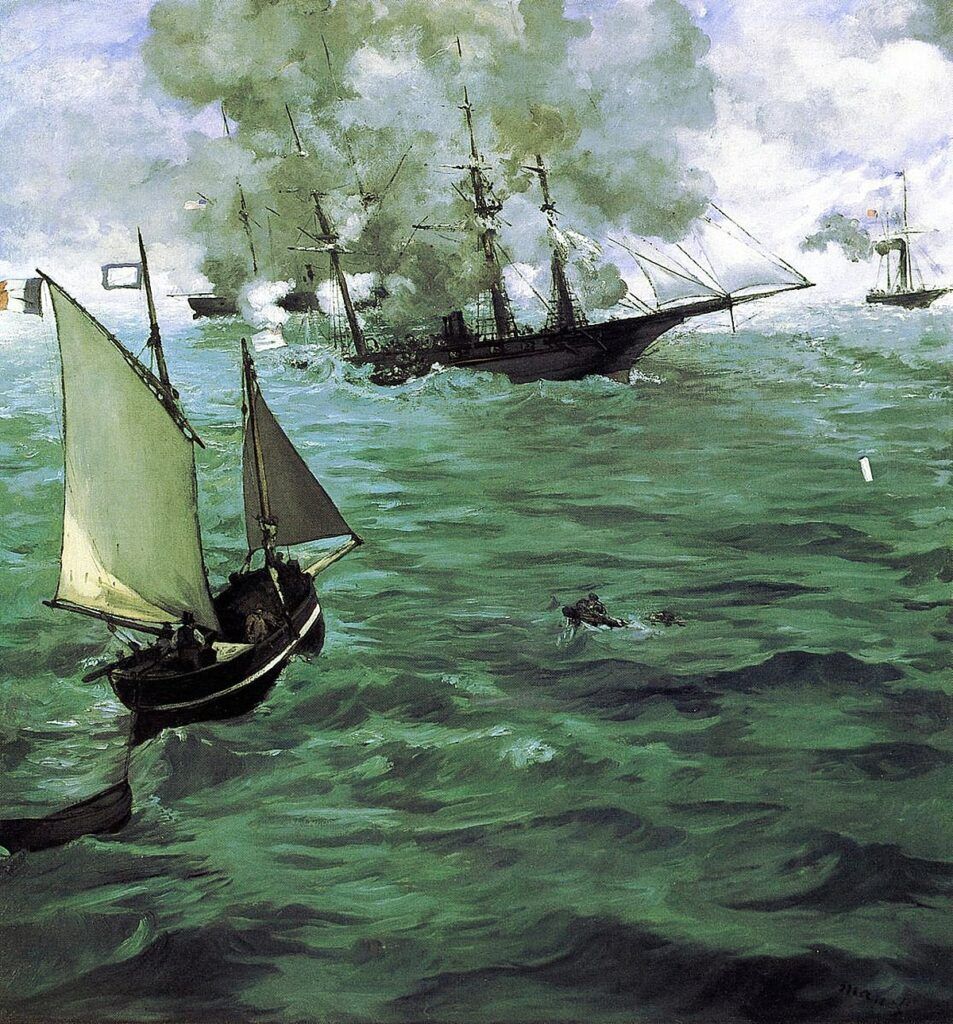
9. Edouard Manet, The Battle of USS Kearsarge and the CSS Alabama
Edouard Manet was a pioneering French artist of the 19th century. He’s often regarded as a bridge between Realism and Impressionism. I just adore his paintings.
This one is one of the greatest paintings ever of the American Civil War. It’s also Manet’s first known seascape.
It depicts an important naval battle set off the coast of France near Cherbourg. The USS Kearsarge was victorious, making headline news. You can see smoke rising from the hit to the CSS Alabama.
The painting was one of Manet’s first depictions of a current event.
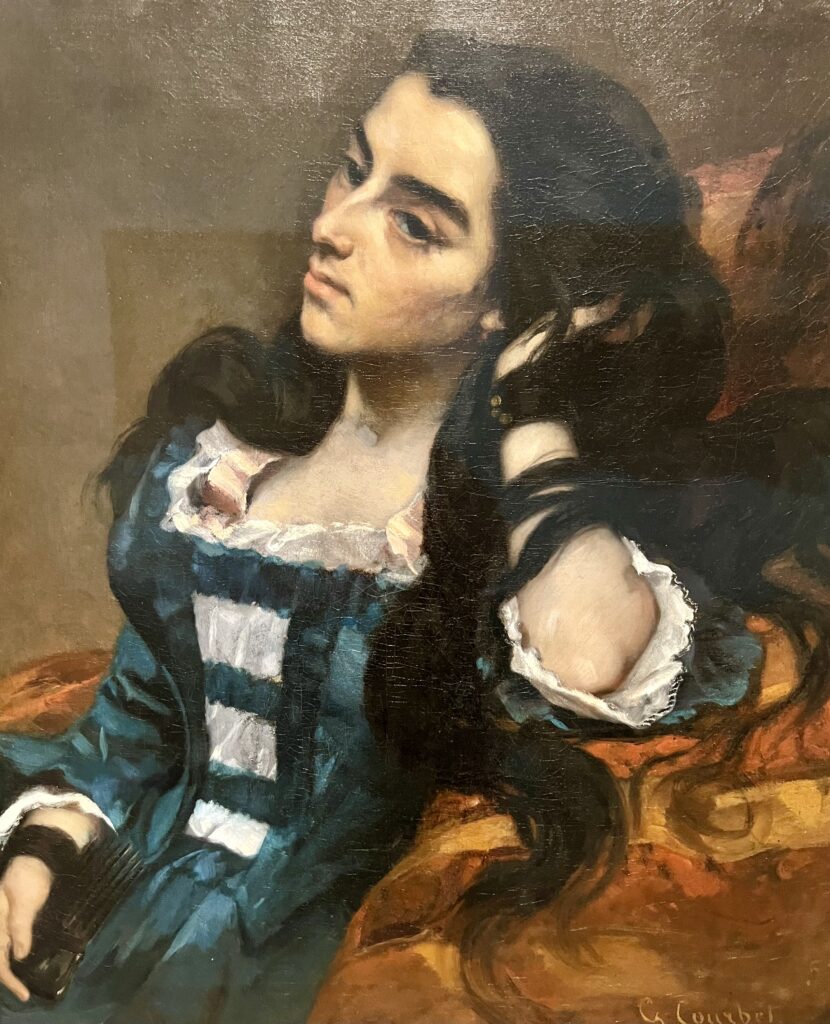
10. Gustave Courbet, Spanish Woman
Gustave Courbet was a 19th century French artist known for his role in the Realist art movement. He gained fame for his bold and unidealized depictions of everyday life.
Courbet often portrayed ordinary people and rural scenes with a keen focus on detail and a rejection of romanticized aesthetics.
In this portrait, he paints a beautiful Spanish woman who once nursed him back to health after cholera.
Though she’s lovely, he shows her with angular facial features and a slumped pose. When the painting debuted, critics disapproved of the painting’s honestly and realism.
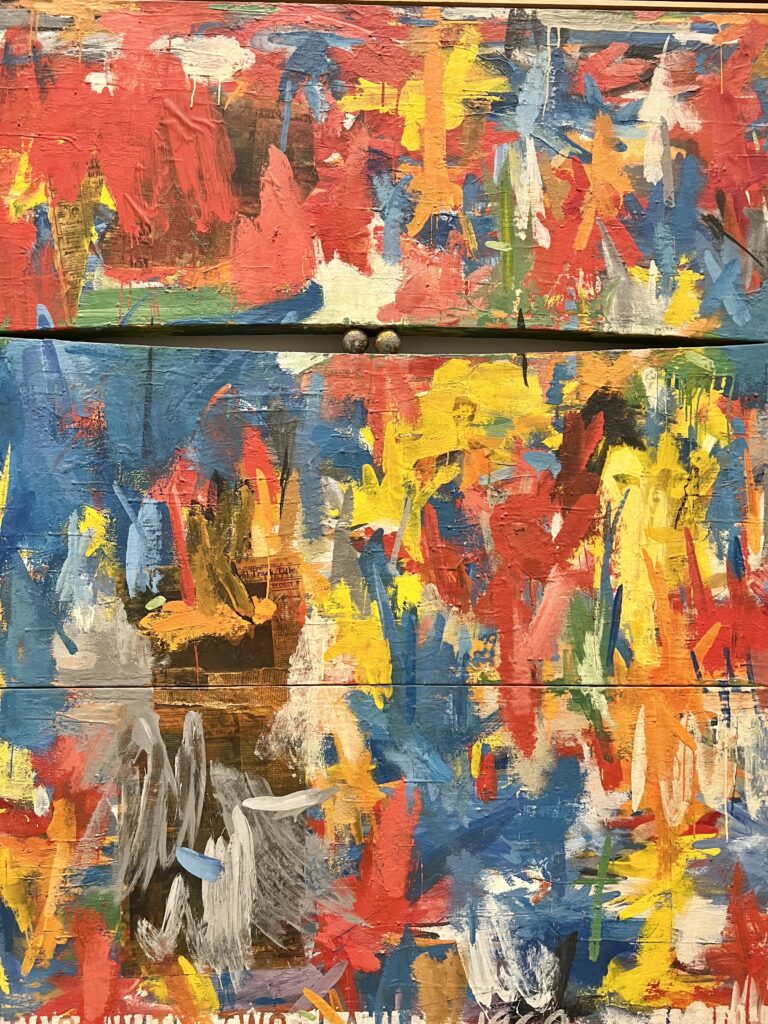
11. Jasper Johns, Painting with Two Balls
Jasper Johns is an iconic American artist known for his significant contributions to the Pop Art and Neo-Dada movements.
He gained fame in the 1950s and 1960s for his sensuously crafted riddles that blurred the line between reality and illusion. He used everyday objects, including flags, targets, and numbers, as subjects in his art.
In the 16 foot tall Two Balls, Johns follows this pattern. The painting is a chaotic landscape of color and gestural brushstrokes.
But Johns meticulously added two baseballs in a gap in the painting. They disrupt the surface, making it appear almost three dimensional.
The choice of baseballs as the subject reflects his interest in ordinary objects. It may also have been a poke at the Abstract Expressionists painters who came before him. They believed that a painting had to be a cerebral and unified painterly field.
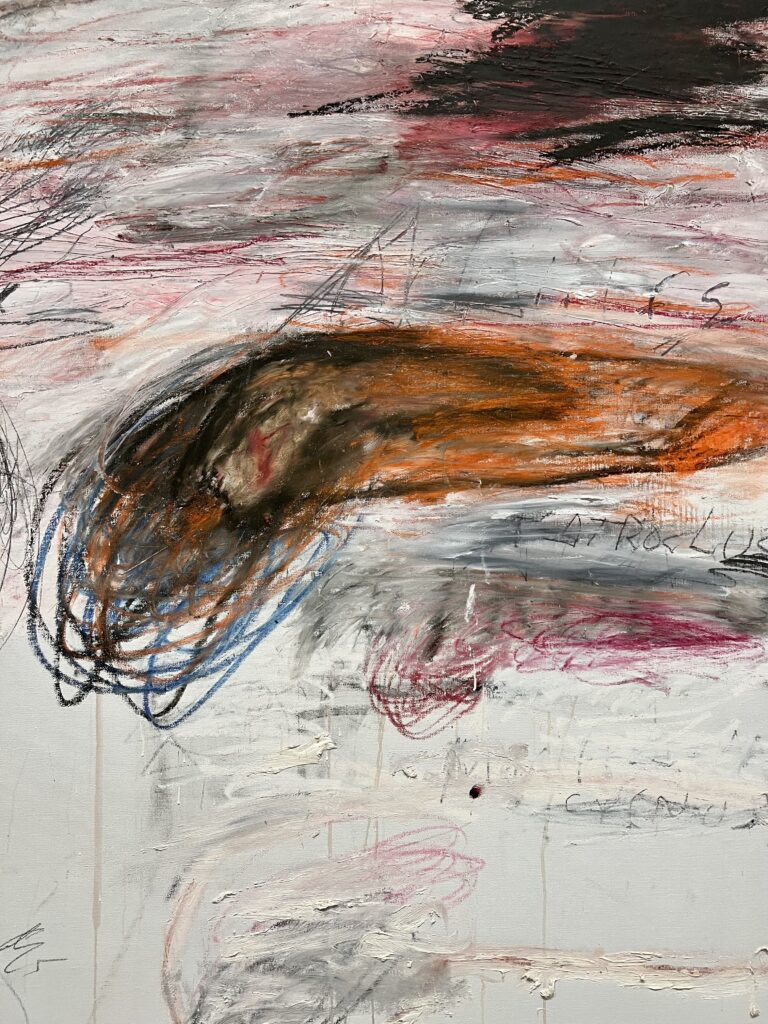
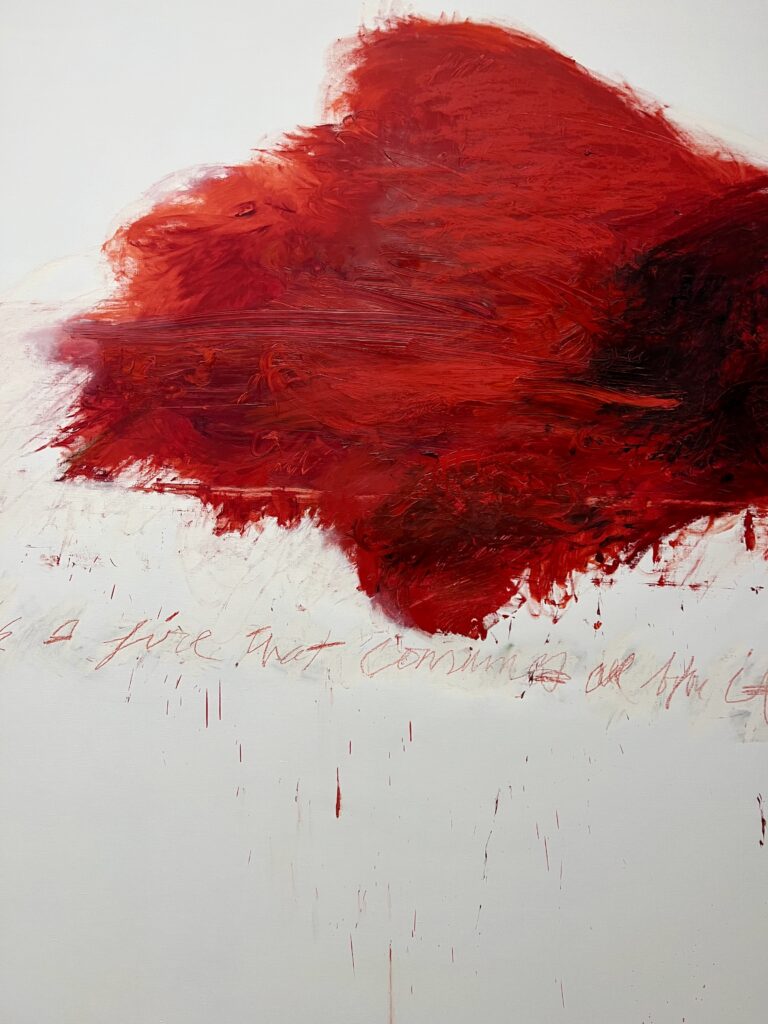
12. Cy Twombly, Fifty Days at Ilium
Twombly is best known for his scribbled, abstract forms and splashes of color that combine fragments of Roman history and mythology. They invite viewers to contemplate the passage of time and the layers of history.
Fifty Days at Ilium is the pinnacle of the artist’s obsession with Greco-Roman mythology. In ten canvases in two rooms, it portrays the last 50 days of the Trojan War, a story of rage and heroism.
You can view the painting sequentially, interpret then in any order, or experience them as an all-encompassing panorama. If you want to really experience them, you’ll need to take some time.
To me, the most arresting paintings are shown above.
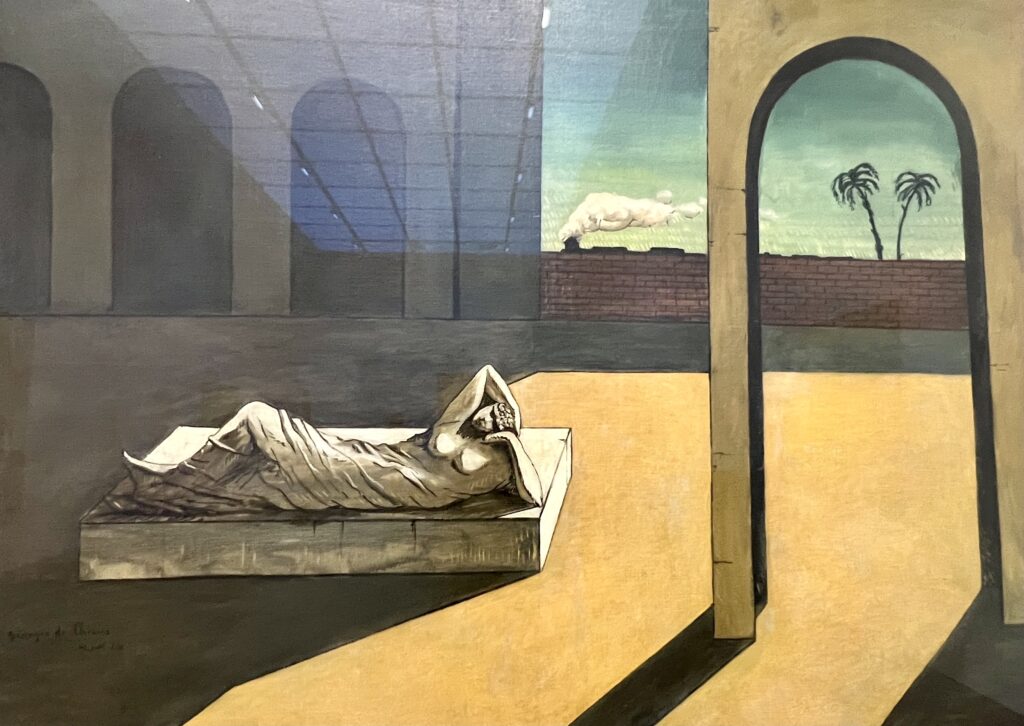
13. De Chirico, The Soothsayer’s Recompense
This is a painting created by the Italian artist Giorgio de Chirico in 1913.
De Chirico was a prominent figure in the Surrealist movement. He’s known for his metaphysical art style, which often featured dreamlike and enigmatic scenes.
This paintings is one of a series of melancholic landscapes. It features a lone statue of the Sleeping Ariadne in an empty Italian piazza. In Greek mythology, Ariadne was abandoned by her lover Theseus on the island of Naxos.
The classical world is contrasted, in the background, with a steam engine in the distance. This creates de Chirico’s trademark — an unsettling ambiguity of time and space.
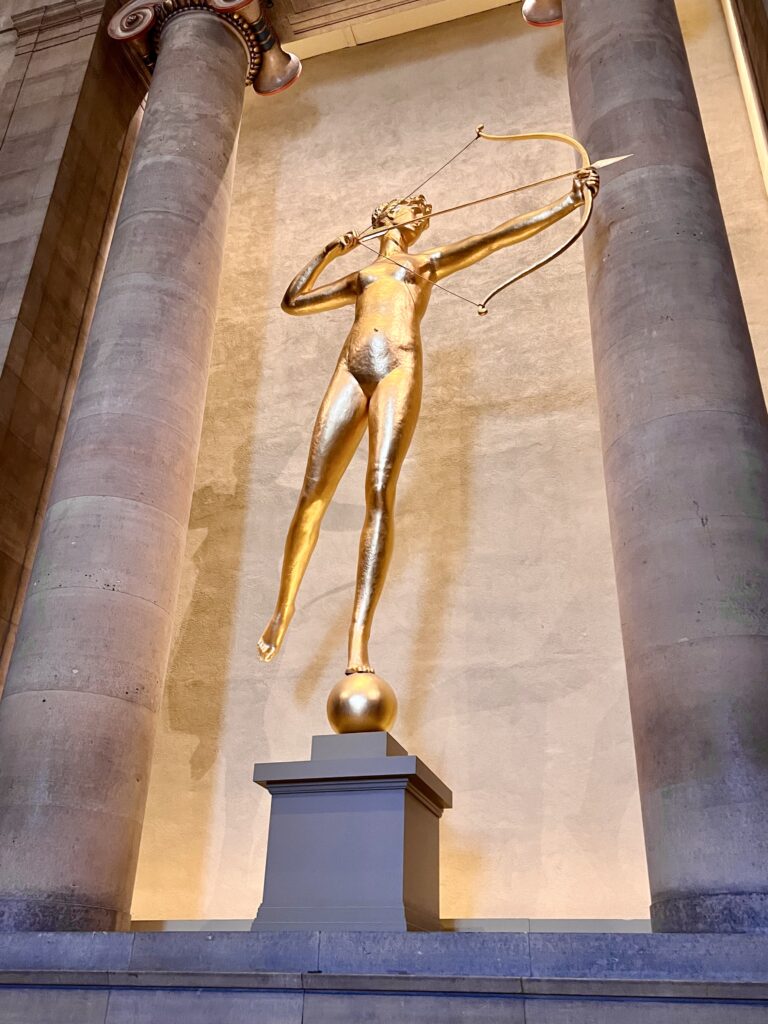
14. Augustus Saint-Gaucens, Dianan, 1892-93
This beautiful 13 foot sculpture greets you as you ascend the staircase of the Great Stair Hall.
Saint-Gaudens was recognized as the finest sculptor in the US at the turn of the century. He is renowned for his contributions in the realm of public monuments and commemorative works.
The Diana sculpture formerly stood in Madison Square Garden. When that site was demolished in 1925, the museum adopted the sculpture.
The sculpture is a beautiful depiction of Diana, the goddess of the hunt. The museum restored the sculpture’s copper core and original gold leaf finish.
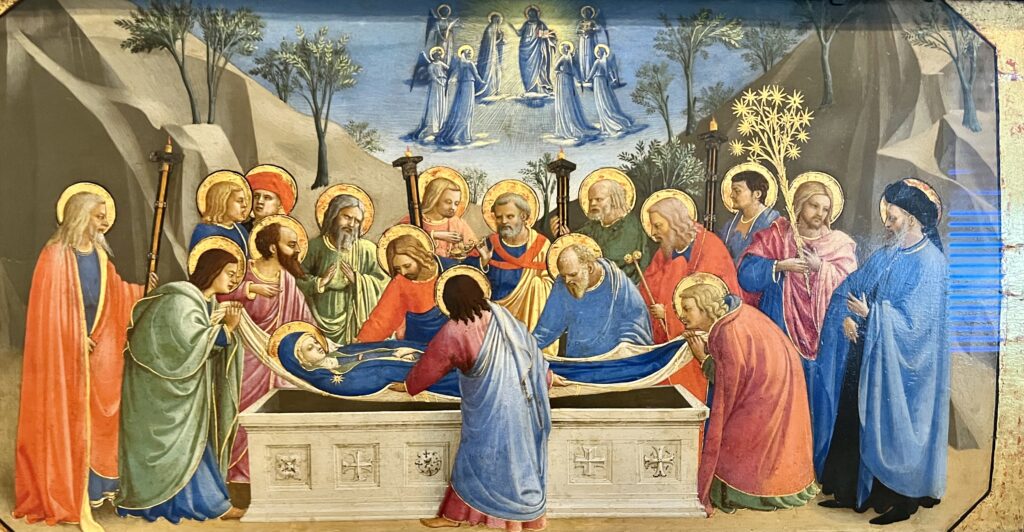
15. Medieval Art
I was astonished at the museum’s first rate collection of medieval and early Renaissance art. Some of it is on loan from the Glencairn Museum, while it undergoes renovations.
In the permanent collection, there are some entire medieval portals and cloisters that have been relocated intact to the museum — the 12th century Portal from the Abbey Church of Saint-Laurent and the Cloister from the Abbey of Saint-Genis-des-Fontaines. You’ll also find stained glass, sculpture, capitols, relics, and artworks.
A few of the most famous paintings are Fra Angelico’s Dormition of the Virgin, Benozzo Gozzoli’s Presentation of Christ in the Temple, Pietro Lorenzetti’s The Virgin and Child Enthroned, and Sandro Botticelli’s Portrait of a Young Man.
READ: Famous Medieval Paintings In Italy
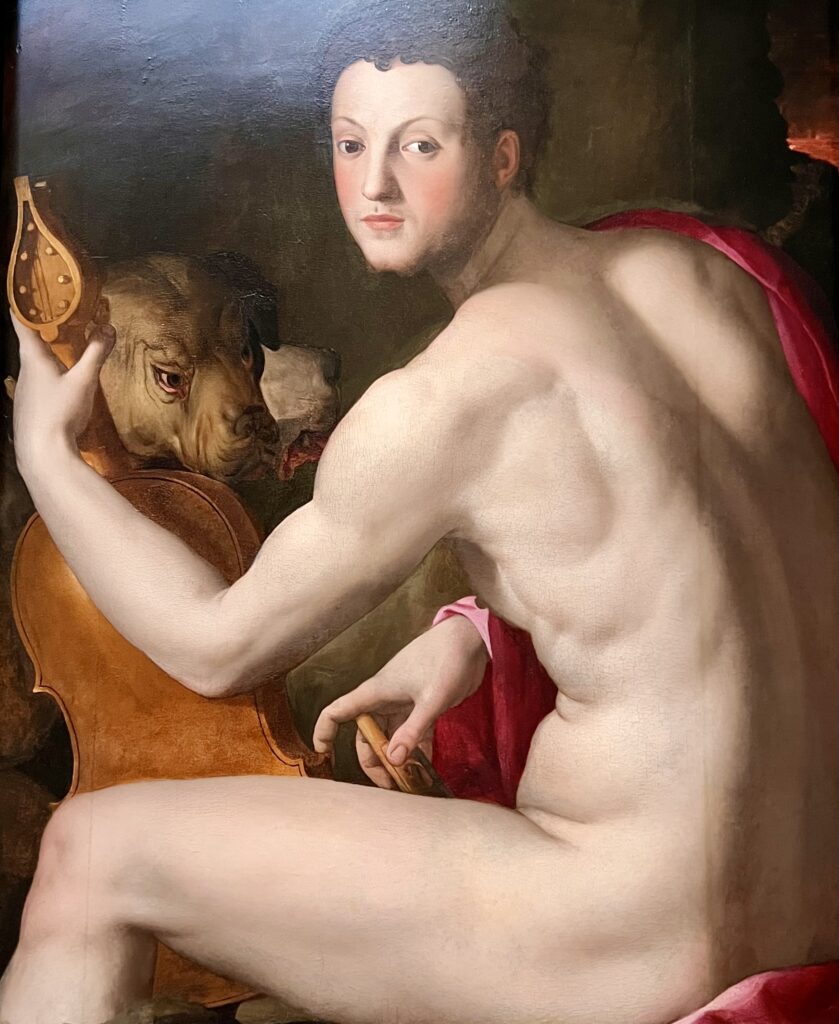
16. Bronzino, Cosimo I As Orpheus
Bronzino was one of the most celebrated Italian Mannerist painters. Mannerism was a period that came after the high Renaissance. Bronzino was especially renowned for his portraits and was the official court painter for the Medici family in Florence.
His works are characterized by their meticulous attention to detail, refined compositions, and an elegant (sometimes enigmatic) portrayal of his subjects.
In this painting, he depicts his patron, Grand Duke Cosimo I. He did a number of propaganda style paintings of the duke to burnish his reputation as the great leader of one of the great Renaissance courts in Italy.
It’s an allegorical portrayal of the duke as the musician Orpheus from Greek mythology. Cosimo is naked, after having used his lyre to charm Cerberus and Hades. It was modeled after the Belvedere Torso in the Vatican Museums.
READ: Famous Mannerist Paintings In Italy
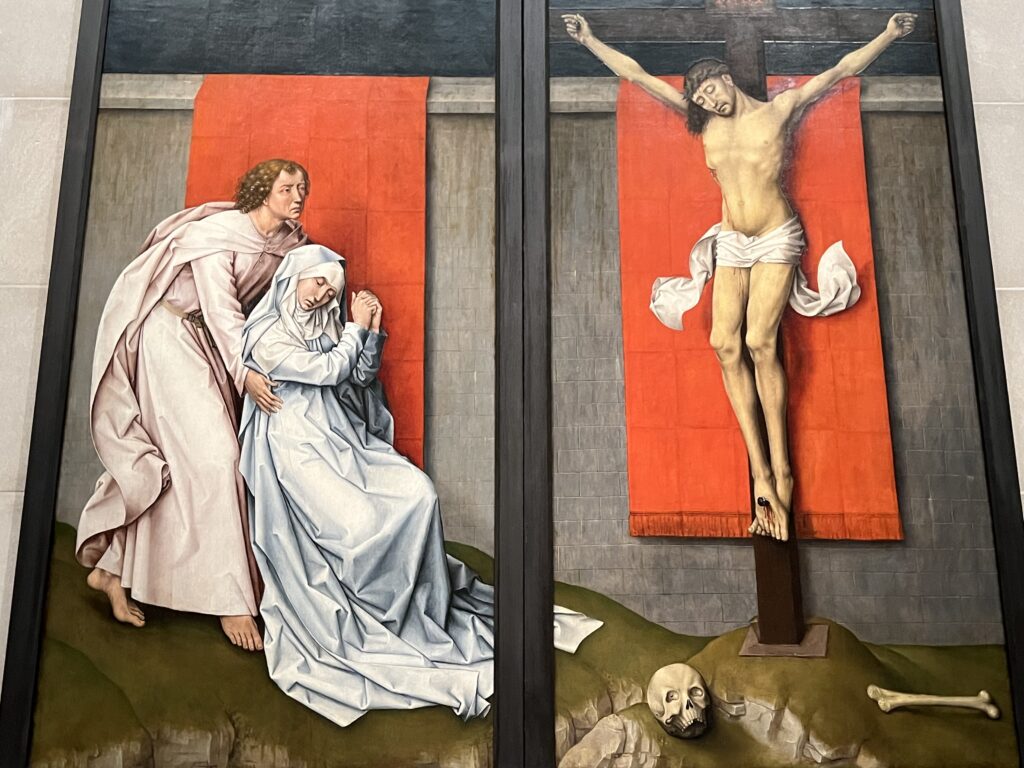
17. Rogier van der Weyden, The Crucifixion
Rogier van der Weyden was a Flemish painter of the Northern Renaissance in the 15th century.
He was celebrated for his emotionally charged and highly detailed religious paintings. They often depicted scenes from the Bible and religious themes.
This painting is one of the museum’s famed Renaissance pieces. It has two panels. They were likely the wings of an altarpiece.
On the left side, you see the Virgin and John the Evangelist openly display their grief. They shed transparent tears over the death of Christ.
On the right is the crucifixion scene. Both scenes are set against red walls, which heighten the painting’s emotional impact.
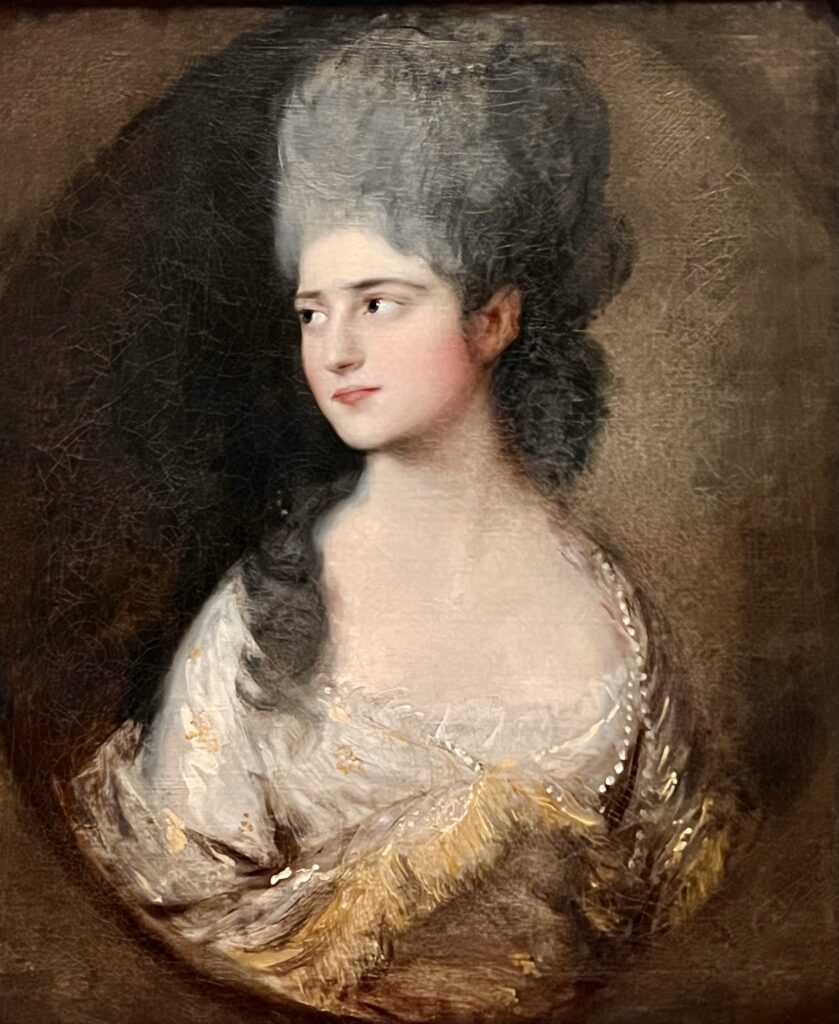
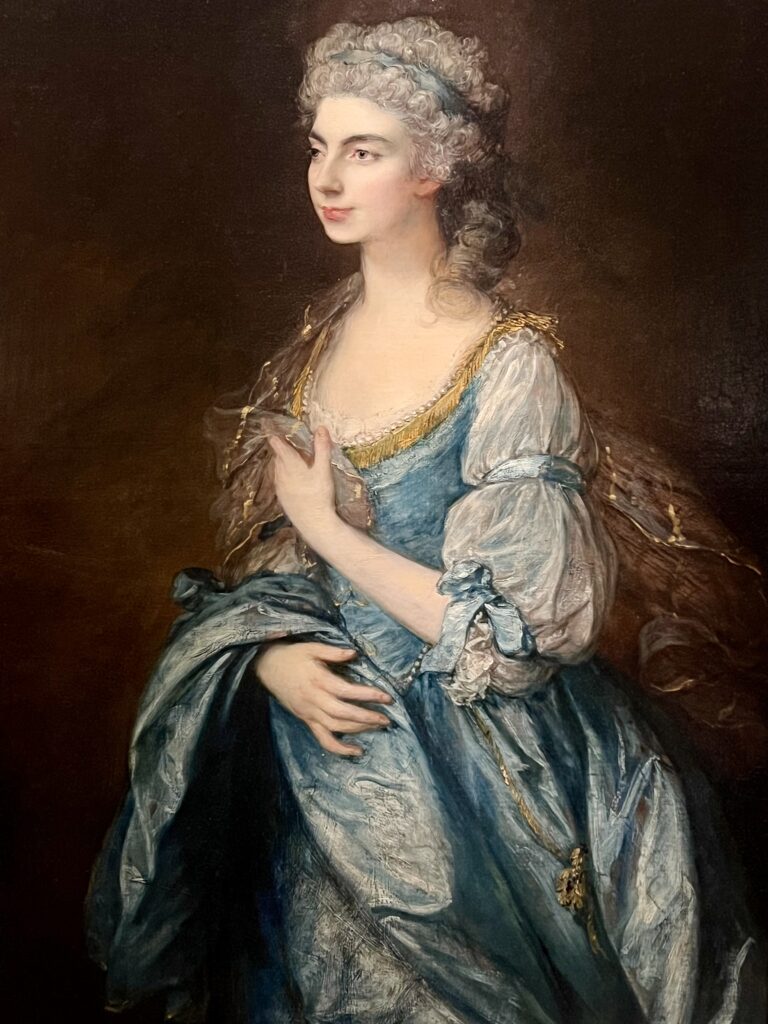
18. British Art
Four rooms in the museum contain British art, architecture, and furnishings that were installed in 1928. They recreate the scale and grandeur of English country houses.
The rooms are filled with art from the 17th to 19th century. The museum owns over 130 British artworks.
There are portraits, landscapes, and scenes of British life. There are artworks by Gainsborough, George Romney, Joshua Reynolds, Hogarth, and others.
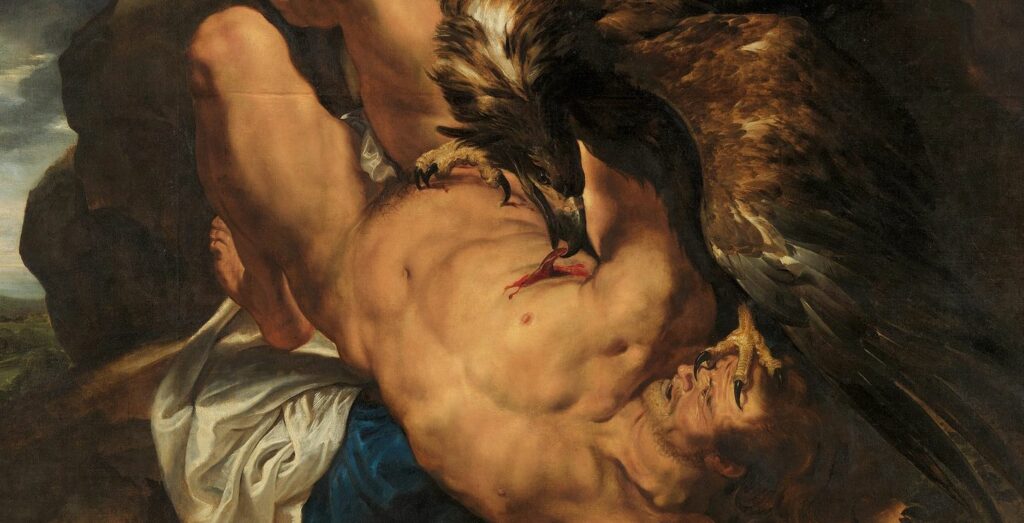
19. Rubens, Prometheus Unbound
Rubens considered this painting to be one of his most important works. It shows the virtuoso artist at the height of his powers. The painting depicts the brutal tale of Prometheus with violence.
Prometheus was the titan who gave fire to humanity. In punishment, Zeus had Prometheus bound to a rock on Mount Caucasus. Each day, an eagle would come to eat Prometheus’s liver, which would regenerate overnight due to his immortality.
The painting is graphic. The enormous bird’s beak rips open the titan’s torso, exposing blood-soaked entrails. One of the eagle’s talons gouges Prometheus’s right eye.
His left eye is locked on the predator, signaling he is fully aware of his torture. His writhing legs, clenched fists, and tousled hair convey his abject agony.
The hulking figure of Prometheus was inspired by Michelangelo’s works. The picture’s asymmetrical composition, in which Prometheus tumbles downward with his left arm almost reaching beyond the canvas, was inspired by a Titian painting.
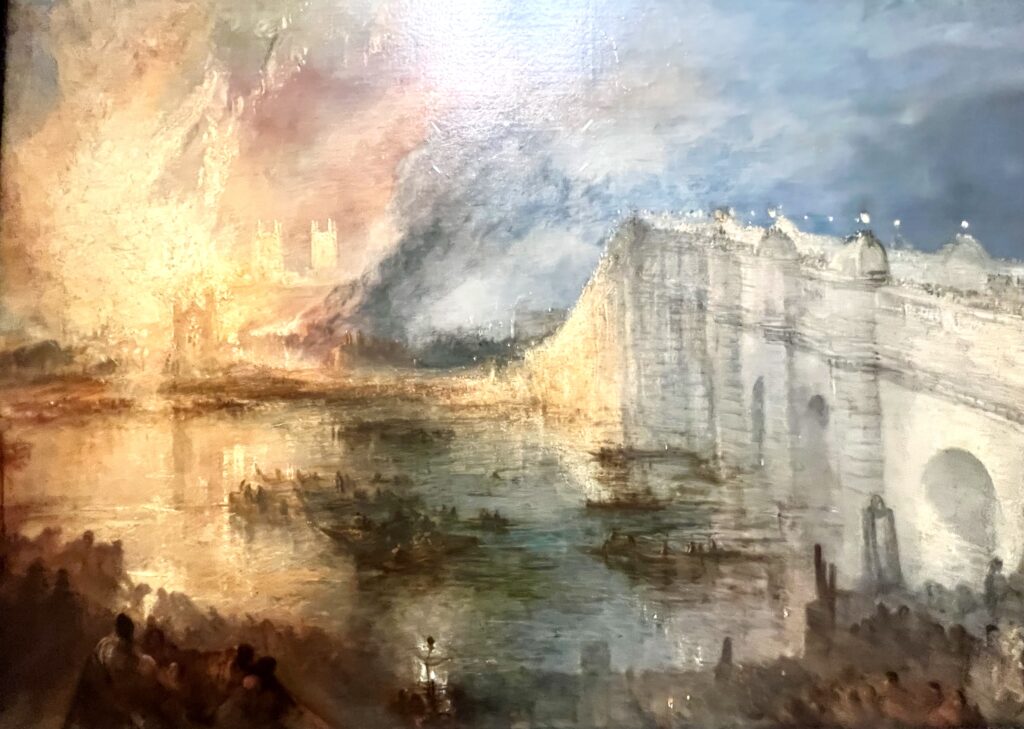
20. Turner, Burning of the Houses of Parliament
J.M.W. Turner was a renowned English Romantic painter known for his mastery of landscape and marine art. His works often conveyed the sublime beauty and power of nature through the use of color and light.
In this painting, Turner depicts the burning of the Houses of Parliament in 1834. He witnessed the event from the south bank of the Thames and recorded what he saw in sketches.
The artist then created this luminous painting (and another on view at the Cleveland Museum of Art). It shows the struggle as boats head toward the flames. The fire is magnified to emphasize the destructive power and man’s helplessness against it.
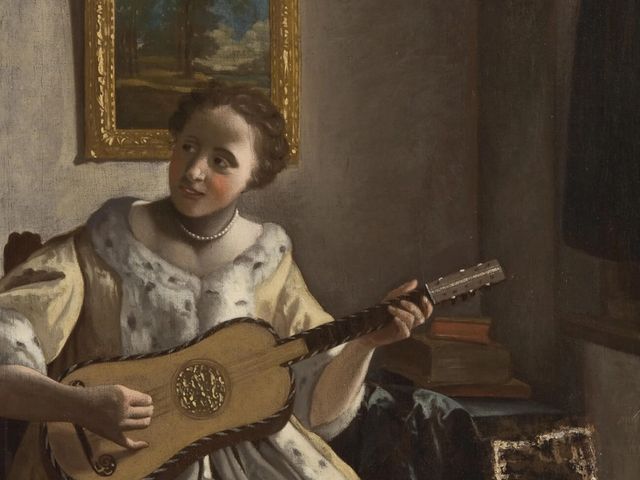
21. Lady With a Guitar
The museums owns a painting, Lady With A guitar, that may or may not be a Vermeer. The famed Dutch Golden Age artist completed only 37 known works, so paintings by him are exceedingly rare.
For years, the painting was thought to be a copy after the Vermeer original, which is in London’s Kenwood House. But that assumption has been challenged by some art historians who now say it’s Vermeer’s own replica.
The painting is not very well conserved. It may have been damaged by a poorly conducted cleaning when the museum acquired it in 1917.
One clue supporting the attribution to the Vermeer is the use of an expensive ultramarine paint that Vermeer favored. The paintings are also almost identical, with the exception of the lady’s hair.
For a long time, the painting was hidden away as historians analyzed it. But it is on view in its unrestored condition. Information panels give a history of efforts to authenticate it.
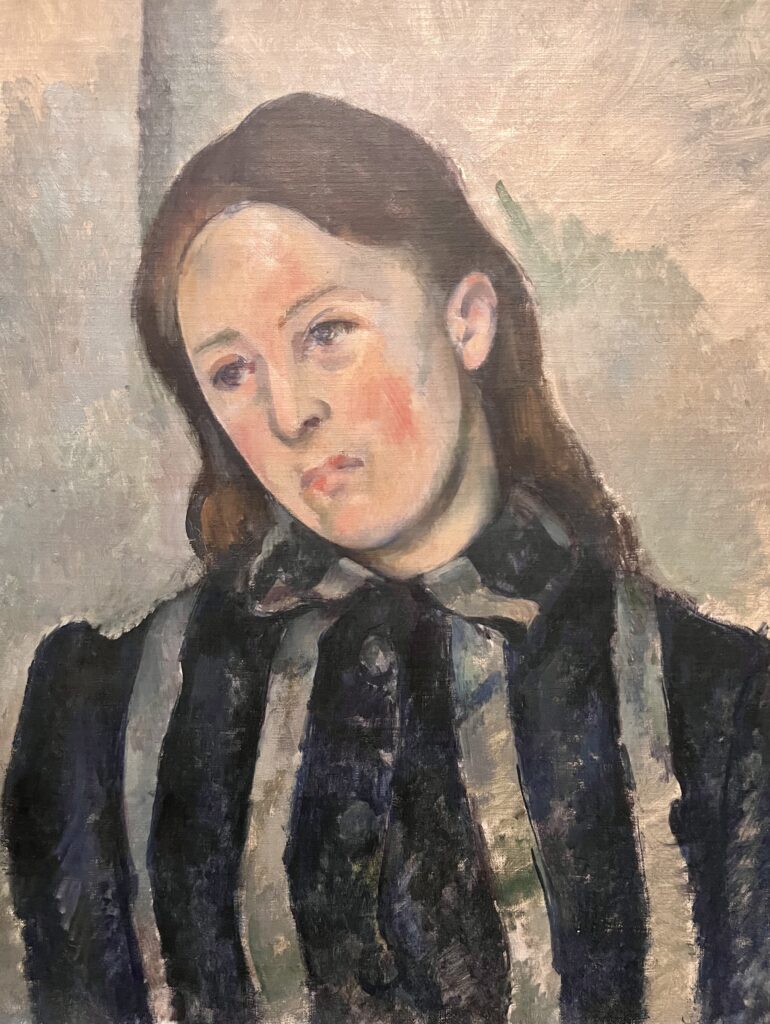
Practical Guide & Tips For The Philadelphia Museum of Art
1. Practical Information
Address: The museum is located at 2600 Benjamin Franklin Parkway.
Hours:
The museum is closed Tuesday and Wednesday, so I don’t recommend visiting the city on those days. The other days of the week the museum is open from 10:00 am to 5:00 pm. On Friday night, it’s open until 8:45 m.
Ticket Price: adults $30, seniors $28, students $14, under 18 free
The museum is also included in the Philadelphia Go City Pass. If you have the pass (like I did), you will need to get in the regular ticket line, have the QR code on your pass scanned, and then get a paper ticket to give to the docent at the museum entry.
Admission is free on the first Sunday of the month and every Friday night from 5:00 pm to 8:45 pm.
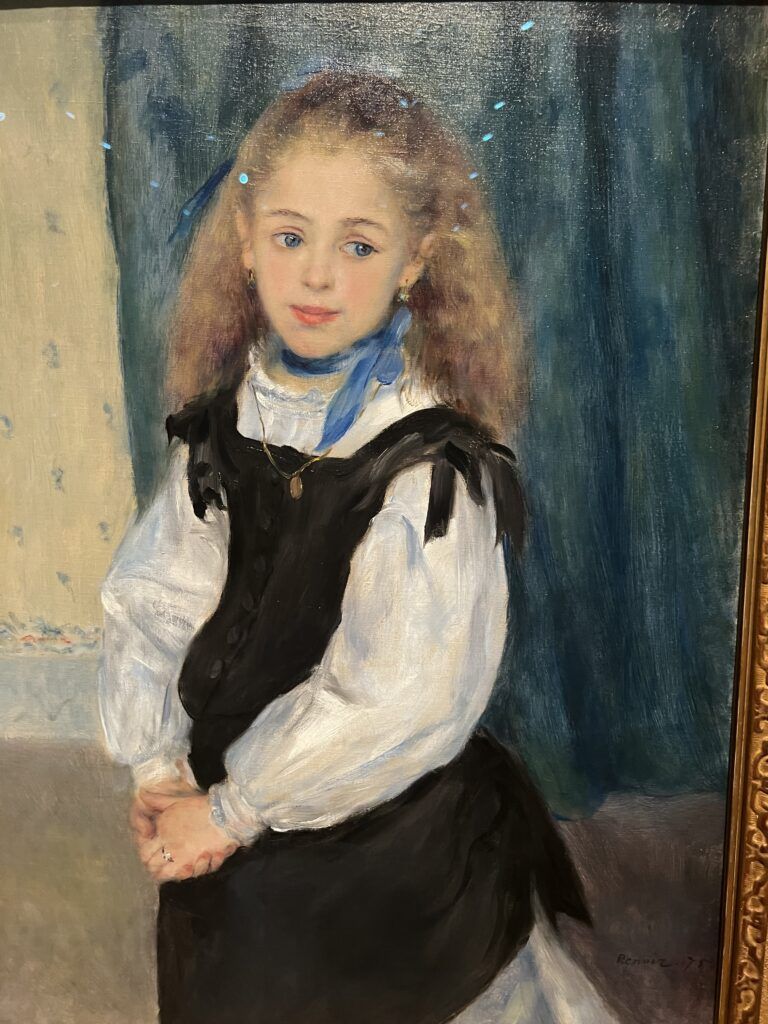
2. How To Get There
The museum is just a short distance from Center City. You can use the city’s public transportation system (subway, buses and trolleys) to get there.
If you tale the subway, SEPTA, to reach the museum, use the Broad Street Line. Get off at the City Hall station and then walk or transfer to a bus for the short journey to the museum.
The PHLASH Downtown Loop and the Hop on Hop Off Bus also stops at the museum.
If you’re driving to the museum, you can use GPS to find the best route. There is a parking lot at the museum. But it can fill up quickly, especially during peak hours and special events.
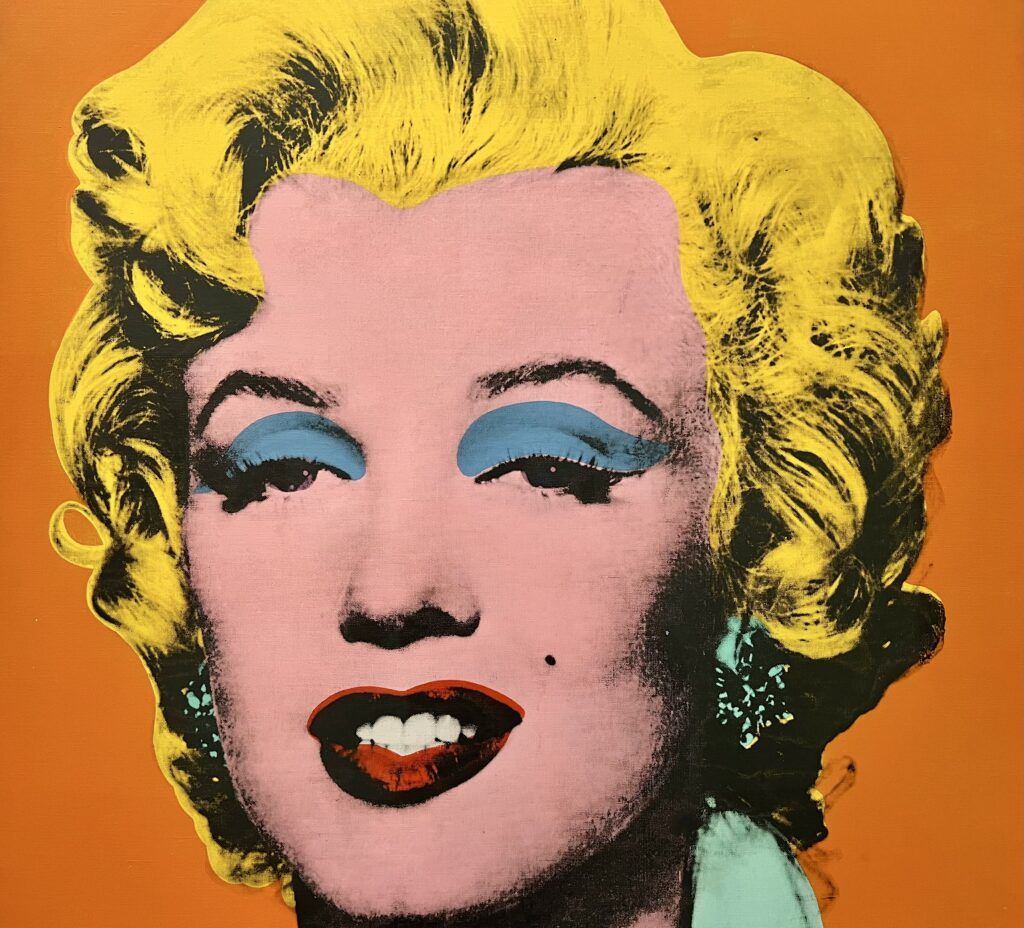
2. How Long To Spend At The Museum
The museum is spread out over 200 galleries. It’s massive.
If you want to see it all, I would plan to dedicate a 3-4 hours. I spent 3 hours there and didn’t see everything. Currently, some of the galleries are closed for renovation, including the armor, Japanese art, and East Asian art spaces.
If you’re not particularly an art lover, I would pick an area or two of interest and focus on them or take the one hour highlights tour. If you only have limited time, head to the Rensnick Rotunda on the second floor to see the museum’s greatest hits.
The museums is so vast and diverse that it really rewards repeat visits.
3. Free Guided Tours
The museum offers guided tours daily at 11:00 am , 12:00 pm, 1:00, 2:00 pm, and 3:0 pm. You can choose among highlights tours, Impressionism tours, American art tours, etc.
Check the website to see which one interests you. Tours meet on the second floor.
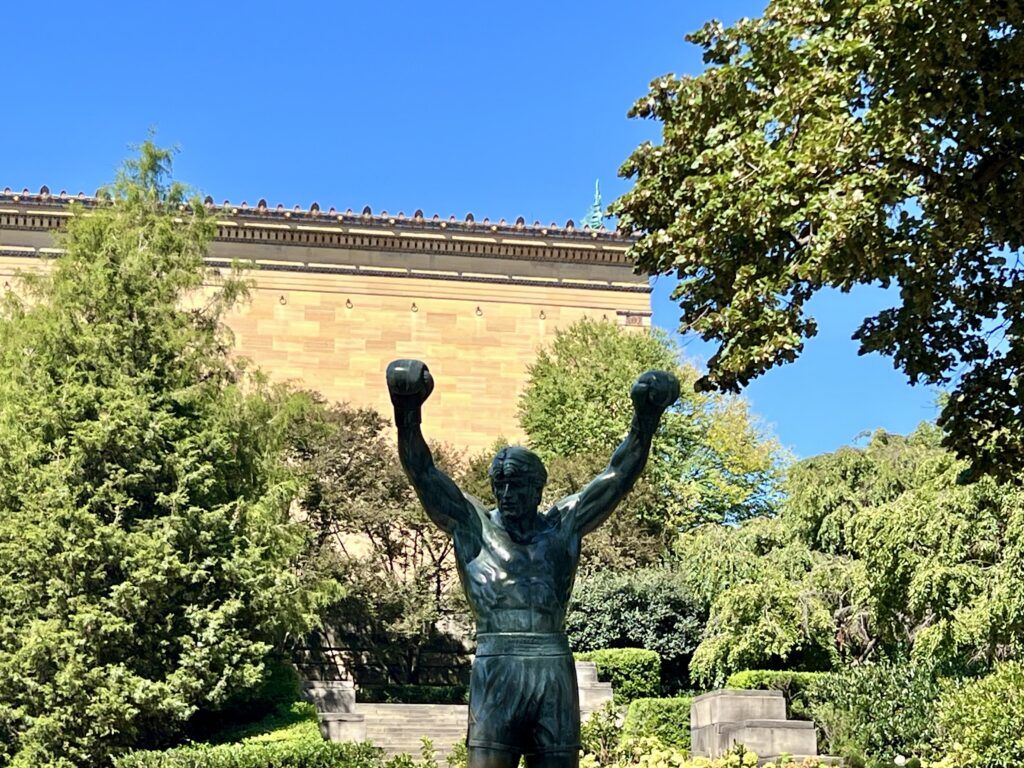
3. Rocky Sculpture
The popular Rocky sculpture is at the base of the Rocky Steps leading up to the museum’s east entrance on the Benjamin Franklin Parkway. It’s to the right side.
The statue is based on the fictional character Rocky Balboa, portrayed by Sylvester Stallone in the “Rocky” film series, which began with the 1976 film “Rocky.” The character is a working-class boxer who becomes a symbol of determination and perseverance.
You’ll find a line to take selfies with the iconic sculpture, which was created by sculptor A. Thomas Schomberg. The statue was a prop used in filming of Rocky III in 1982 and was later donated to the city of Philadelphia.
>>> Click here to book a tour of Rocky filming locations
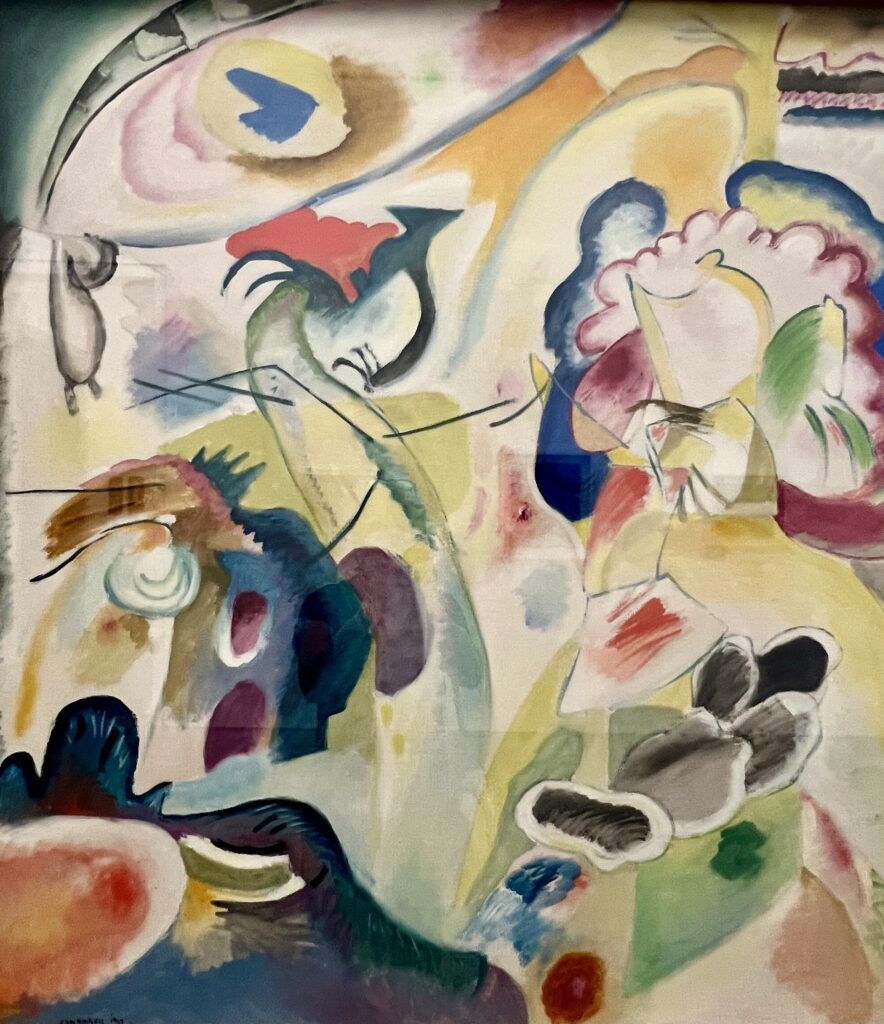
4. Cafes
There are three places to eat at the museum. The Espresso Bar is on the ground floor. Stir Restaurant is on the first floor. The Balcony Cafe is on the second floor.
5. Museums Stores
The museum has four stores spread out through the museum. It’s a nicely curated selection of books, gifts, posters, drawing tools, and local artisan wares.
6. Other Attractions Near The Museum
There are a slew of other attractions near the museum. If you want more art, you can visit the Rodin Museum and the Barnes Foundation. They are small, but excellent, museums.
Logan Square is only about .5 miles from the museum. You can stroll there, admire the Swan Memorial Fountain, and then check out the Cathedral of Saint Peter and Saint Paul.
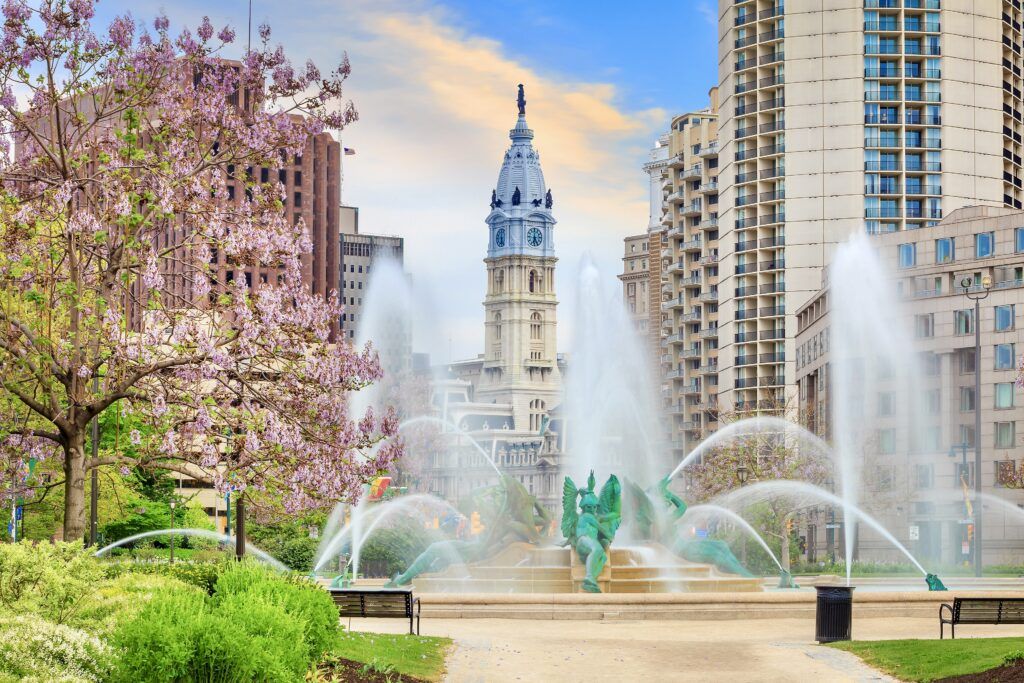
The museum is also only 1 mile from City Hall. You can make a reservation to climb the tower, check out the LOVE sculpture, and then head to Reading Terminal Market for lunch or dinner.
I hope you’ve enjoyed my guide to the Philadelphia Museum of Art. You may enjoy these other Philadelphia travel guides and resources:
- 2 days in Philadelphia itinerary
- Top Attractions in Philadelphia
- 2 Days in Washington D.C Itinerary
- 2 days in Denver itinerary
- 2 days in Cleveland itinerary
- 3 Day Itinerary for Boston
- 1 Day Itinerary for Cambridge
- 7-10 Day Itinerary for Vermont
- 10 Day Itinerary for New Hampshire
- 25 Most Beautiful Towns in New England
- 10 Day Itinerary for Coastal Maine
- Fall Foliage Road Trip in New England
If you need a guide to visit the Philadelphia Museum of Art, pin it for later.

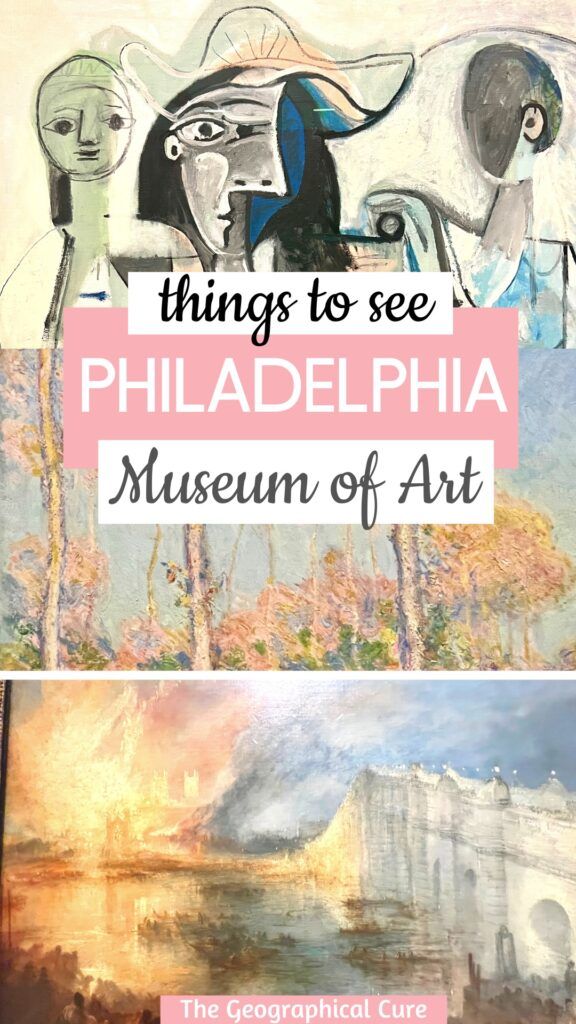
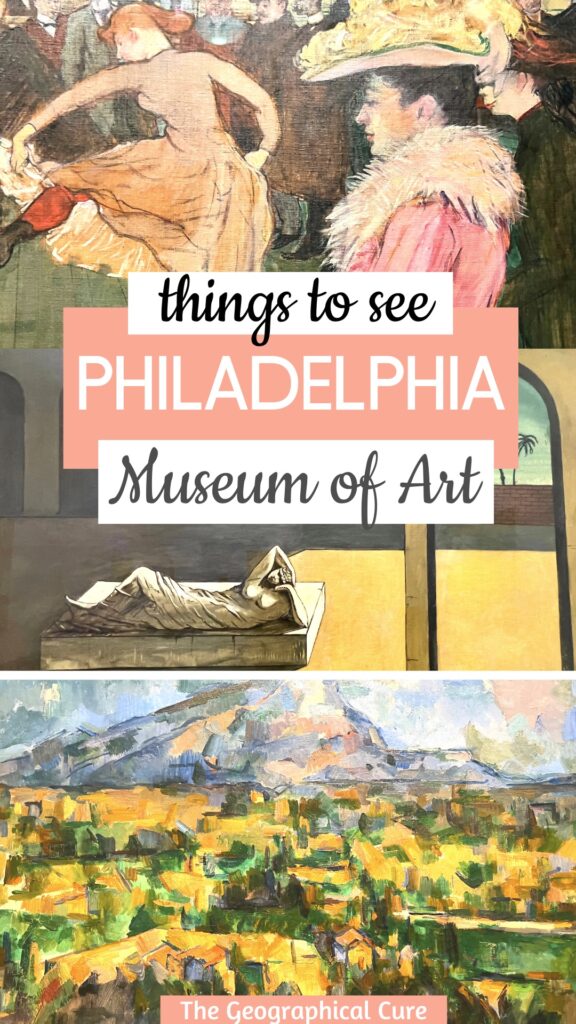
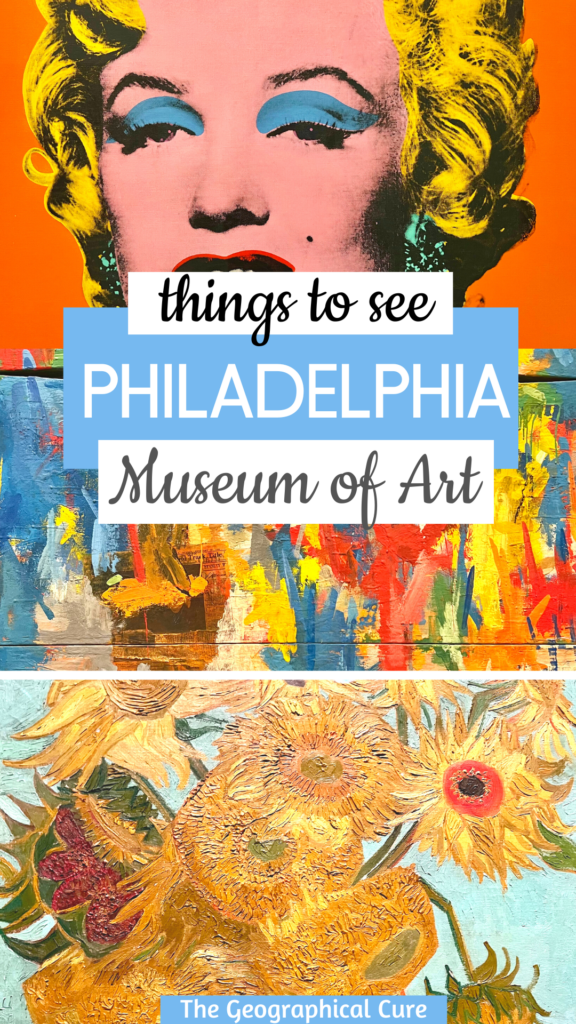
Thank-you for this well-written and informative list — it helped me decide which parts of the museum to focus on. Keep up the great work!
Have a great visit Richard. It’s an amazing museum.